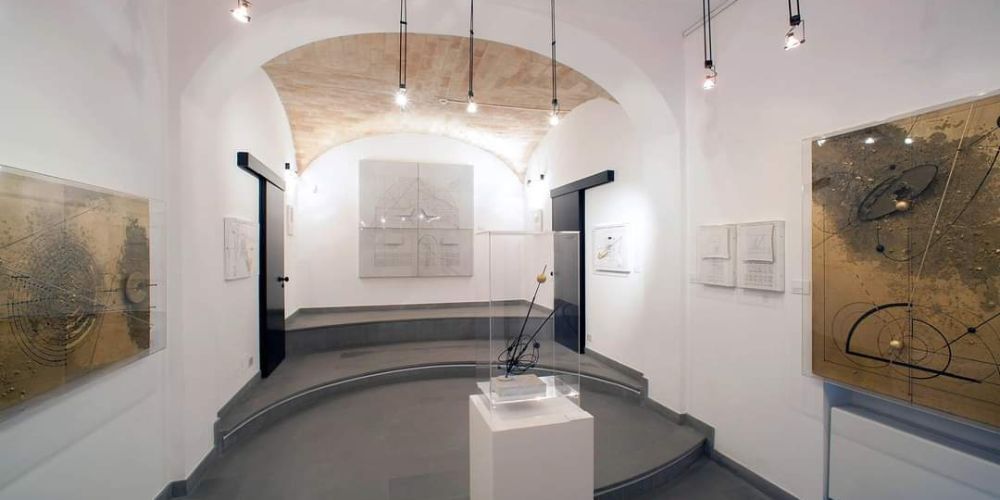Osvaldo Licini and his works embody an art made of symbols and expressive freedom, inspired by the landscape and quiet of Monte Vidon Corrado, a village in the Marche region where he was born and spent most of his life. His House Museum now offers an intimate and immersive experience among the rooms where the artist lived and created, accompanied by his wife Nanny Hellström, Swedish artist and his muse. With Licini, art goes beyond the canvas, integrating with the personal and political events of the artist, between abstractionism, fantastic figurativism and his commitment to his community.
Visiting the Casa Museo Osvaldo Licini means entering a dreamlike universe, where every room and every work evokes profound emotions. Works such as the ‘Amalasunte’ and the ‘Rebel Angels’ reveal the visionary and free character of the artist, always in search of new meanings and an aesthetic truth that combines art, politics and natural beauty. An experience, in short, that goes beyond art to recount the life of Osvaldo Licini and his works in their most authentic context.

Osvaldo Licini and his works: a journey from the Parisian avant-garde to the heart of Le Marche

After studying at the Academy of Fine Arts in Bologna, Osvaldo Licini landed in Paris, where he came into contact with the avant-garde and made friends with artists such as Picasso and Modigliani. In this vibrant environment, Licini began to explore abstract language, feeding his style with Cubist and Surrealist elements. But in 1926 he made a counter-current decision: he left Paris to return to Monte Vidon Corrado with his wife Nanny Hellström, whom he had met in the French capital.
Here, in the hills of the Marche region, Licini found the ideal space to give voice to his artistic language. Nanny, a cultured and refined painter, enriches the atmosphere of the house with her Swedish culture and brings an international touch with her Nordic furniture and objects. Monte Vidon Corrado thus becomes a creative haven for Osvaldo Licini and his works, where the artist can experiment and renew his style in freedom. His art matured, moving from abstractionism to fantastic figurativism, leading Licini to create masterpieces that combine beauty, mystery and the charm of the Marche landscape.
The Artistic Phases of Osvaldo Licini and His Works: From Abstractionism to Fantastic Creatures

Osvaldo Licini and his works pass through stylistic phases that reflect his life course and the influences of the European avant-garde. In the early years, Licini devoted himself to figurativism, focusing on portraits and landscapes that delicately reflect nature and the human figure. In the 1930s, however, his painting evolved into an abstractionism made up of geometric shapes, clear spaces and bold colours, with works that reflected his restless soul and the need to go beyond tangible reality.
In the 1940s, a new artistic phase was born: ‘fantastic figurativism’, a language that combines abstractionism with surrealism. His works are populated with enigmatic creatures such as the famous ‘Amalasunte’ and the ‘Rebel Angels’, symbolic representations of his vision of freedom and inner rebellion. These dreamlike figures, suspended between heaven and earth, embody a unique artistic and spiritual ideal that makes Osvaldo Licini and his works unmistakable in the artistic panorama of the 20th century.
Nanny Hellström and the central role in Osvaldo Licini's works

Nanny Hellström, Osvaldo Licini's wife and muse, made an essential contribution to the artist's universe. Swedish, refined and cultured, Nanny brought a different culture to Monte Vidon Corrado, enriching the house with Nordic objects and furnishings that today can be admired in the House Museum. Her modern taste and sensitivity influenced Licini, who found in her not only a life companion, but a constant source of inspiration.
Nanny was also a fundamental presence in the organisational and political aspect of Licini's life, supporting him in his commitment to the community. In the House Museum, one can perceive their deep bond, which shines through in the details of the furniture and the works that decorate each room. Their relationship created a unique synergy, where art and life intertwine in an intimate and poetic reality.
The Political Commitment of Osvaldo Licini and his symbolic works

In 1946, in an Italy emerging from the world conflict, Osvaldo Licini devoted himself to local politics and was elected mayor of Monte Vidon Corrado with the ‘Spiga di Grano’ list. In this role, Licini worked to improve conditions in his village, promoting culture and the social welfare of the community. The cellar of his house, now part of the House Museum, was a meeting place where ideas were discussed, combining his role as an artist with that of an active and committed citizen.
Licini's political commitment is an extension of his artistic vision, a desire to improve the world around him and to give a voice to those who do not have one. Licini experienced politics as an art form, a way of creating not only pictorial works but also a better future for Monte Vidon Corrado. This civic dimension is reflected in his works, where each fantastic figure represents the desire for change, freedom and rebellion against imposed limits.
The Osvaldo Licini House Museum: Discovering the Life Behind the Works

The Osvaldo Licini House Museum is now a place of inspiration, where art and life meet and where each room tells a chapter of the artist's life. The Nordic-style furnishings brought by Nanny and Licini's symbolic works make the house a temple of creativity and memory. Here, the living room houses works such as ‘Portrait of the Mother’ and ‘Landscape’, which express the artist's bond with his Marche roots.
On the upper floor, the studio where Licini painted with a view of the hills is the heart of the house. Every element, from family objects to canvases, creates a continuous dialogue between the past and the present, allowing visitors to fully immerse themselves in the universe of Osvaldo Licini and his works. An authentic experience, which is not limited to art but extends to daily life and the artist's deep bond with his land.
The Osvaldo Licini Study Centre: Enhancing the heritage of a master

Alongside the House Museum, the Osvaldo Licini Study Centre continues to keep his memory alive through exhibitions, conferences and cultural activities. Founded in 1986, the centre is a point of reference for scholars, artists and art lovers. It is here that Licini's history and works are continuously enhanced, in a dialogue between generations that honours the artist's artistic and political vision.
Through the initiatives of the Study Centre, Monte Vidon Corrado becomes an important cultural centre, where Osvaldo Licini and his works are celebrated, but also the philosophy and thought of the man behind each brushstroke. A place where the present meets the past, and where Licini's ideas continue to inspire new talents.
About the author
Written on 04/11/2024


Simone Spolitu
Osvaldo Licini and his works: a journey through art, politics and Marche landscapes in his House Museum.